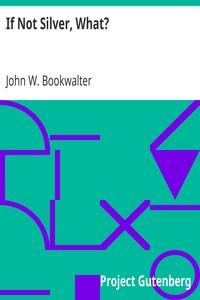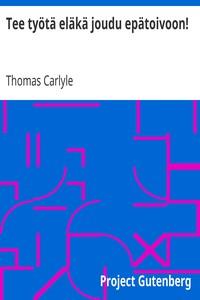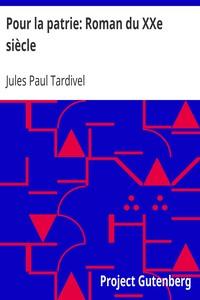|
|
Read this ebook for free! No credit card needed, absolutely nothing to pay.Words: 29939 in 6 pages
This is an ebook sharing website. You can read the uploaded ebooks for free here. No credit cards needed, nothing to pay. If you want to own a digital copy of the ebook, or want to read offline with your favorite ebook-reader, then you can choose to buy and download the ebook. empered and revengeful as the Moors. If not, why not? They all have the gold standard. You may say that this answer is foolish, and I don't think much of it myself, but it is strictly according to Scripture . The retort is on a par with the proposition, and both are claptrap. The progress of nations and their rank in civilization depend on causes quite aside from the metal basis of their money. We must remember that for many years after the establishment of the Mint we had in this country little or no coin in circulation except silver, and were just as much on a silver basis then as Mexico is now. Were our forefathers, then, inferior to us, or on a par with the Mexicans and Chinamen of the present day? Even down to 1840 the silver in circulation greatly exceeded the gold in amount. In all the Spanish American States there are 60,000,000 people, and they have a little less than 0,000,000 in silver. Not per capita! This is a startling statement, I know, but it is official, and you will find it in the last report of the Director of the Mint . The South American States have but 83 cents per capita in silver, and Mexico has but .50. With a population nearly twice that of Great Britain, they have much less silver, and less than half of that of Germany, though having a much larger population. In fact, to give the Spanish American nations as large a silver circulation per capita as the average of England, France and Germany, they must needs have nearly 0,000,000 more, or nearly three times as much as they now have. It looks very much as if the "dump" would have to be the other way. There is no such thing as intrinsic value. Qualities are intrinsic; value is a relation between exchangeable commodities, and, in the eternal nature of things, never can be invariable. Value is of the mind; it is the estimate placed upon a salable article by those able and willing to buy it. I have seen water sell on the Sahara at two francs a bucketful. Was that its intrinsic value? If so, what is its intrinsic value on Lake Superior? No more than an invariable standard of friendship or love. Value is, in fact, a purely ideal relation. All this talk about an invariable dollar which shall be like the bushel measure or the yard stick is the merest claptrap. The fact that gold men stoop to such language goes far to prove that their contention is wrong. The argument violates the very first principle of mental philosophy, in that it applies the fixed relations of space, weight, and time to the operations of the mind. Would you say a bushel of discontent or eighteen inches of friendship? Men who compare the dollar to the pound weight or yard stick are talking just that unscientifically. Invariable value being an impossibility, and an invariable standard of value a correlative impossibility, all we can do is to select those commodities which vary the least and use them as a measure for other things; but you will not find in any economic writer that any metal is a fixed standard. And this brings me to consider that singular piece of folly which furnishes the basis of so much monometallist literature, namely, that gold is less variable in value than silver, and that one metal as a basis varies less than two. Some of our statesmen have got themselves into such a condition of mind on this point as to really believe that, while all other products of human labor are changing in value, gold alone is gifted with the great attribute of God--immutability. It is sheer blasphemy. It is conclusively proved, and by many different lines of reasoning, that silver is many times more stable in value than gold. In February, 1873, a ten-ounce bar of uncoined silver sold in New York city for in gold, or .82 in greenbacks. To-day the ten-ounce bar sells there for .90. Going through a long list in the same manner, we find that the ten-ounce bar of uncoined silver would buy in '73, in New York city, twenty-three and a half bushels of corn, to-day twenty-four bushels; of cotton then eighty pounds, to-day eighty-six pounds--and there is "a great speculative boom in cotton," and has been for some time, but on the average price of this year silver would buy much more. Of rye, then about fifteen bushels , to-day thirteen bushels; of bar iron then 310 pounds, to-day 460 pounds, and so on through the market. In the Central West in 1873 it would have taken ten such silver bars to buy a standard farm horse, Clydesdale or Percheron-Norman. Will it take anymore bars to-day at .90 each? There is another way to calculate the decline, and that is by taking the average farm value instead of the export or New York city price, and including all roots and garden products not exported, and this makes the showing far more favorable to silver. The Agricultural Department at Washington has recently issued a pamphlet showing the crops of every year since 1870, and the average home or farm price, together with the total for which the whole crop was sold. Send for it and contrast the prices given in it with those known to you to-day, and you will find that in rye, barley, oats, potatoes, and many other things the decline has been very much greater than is given above. In short, it takes more farm produce to buy an ounce of silver than it did in 1873, and twice as much to buy an ounce of gold. Of Ohio medium scoured wool, for instance--and that is the standard wool of the market--it would have taken in 1873 two and a half pounds to have bought an ounce of silver, while to-day it will take considerably over three pounds. The monometallists habitually talk, and have talked it so long that they believe it themselves, as if silver had become so cheap that the farmer ought to rank it with tin, lead, or spelter; but if the farmer will try the experiment he will find that it takes a good deal more of his product to buy a given amount of silver than it did in 1873. The plain truth of the matter is that the time has come for both gold and silver to increase in purchasing power; but by reason of demonetization almost the entire increase has been concentrated in gold, leaving silver almost stationary as to commodities in general, but somewhat enhanced as to farm products. In the name of common, honesty, is it not a high-handed outrage to make the old debts of that period payable in the rapidly appreciating metal, instead of one that has merely retained its value? and is it not hypocrisy to speak of such a system as "honest money," and affect to deplore the dishonesty of those who insist upon their right to pay in the least variable metal, which was constitutional and the unit of our money from the very start? Gospel truth! And there is but one kind of perfectly honest money--that which will give the creditor an equivalent in commodities for what he could have bought with the money he loaned. Surely no honest man will pretend that gold to-day does that. At this point we must admit the painful truth that, in that sense, there is no perfectly honest money, that is, no money that does not change somewhat in purchasing power; and how to remedy this has been the great problem with the greatest minds among financiers--with all financiers, in fact, who are more anxious for justice than greedy of gain. But surely there should not be added to an innate variability that much greater variability due to the mischievous interference of interested parties, through the power of the government. And herein is made manifest the reckless folly of the gold men in fighting against the soundest conclusions of science and honesty, in striving for a standard of one metal allowing the greatest variation, instead of two which by varying in different directions might counteract each other. Gold alone has varied in production in this century from ,000,000 to 0,000,000 per year, or tenfold; but gold and silver combined have never varied more than sixfold. It is self evident, therefore, that the two combined form a much more stable mass than gold alone, and it cannot be too often repeated that the great desideratum in money, the one quality more important than all others, is stability in value, to the end that a dollar or pound or franc may command as nearly as possible the same amount of commodities when a contract is completed as when it is made. Economists dispute about almost everything else, but they are unanimous in this: That a money which changes rapidly in purchasing power is destructive of all stability and even of commercial morality. Will anybody pretend that gold has not changed rapidly in purchasing power within the last twenty years? Has not the universal experience shown that the variation has been very much greater in one metal than it ever was when the two metals were treated equally at the mint? The very least that could be asked on the score of honesty would be free coinage of both, with a proviso that debts should be paid with one-half of each. Back of all that, however, comes in the great principle of compensatory action, the variation of one metal counteracting that of the other; and from the standpoint of pure science and honesty it is greatly to be regretted that, instead of two precious metals, we have not at least five. Free books android app tbrJar TBR JAR Read Free books online gutenberg More posts by @FreeBooks
: Tee työtä eläkä joudu epätoivoon! by Carlyle Thomas Brummer Uno Translator - Philosophy@FreeBooksTue 06 Jun, 2023

: The Art of Public Speaking by Carnegie Dale Esenwein J Berg Joseph Berg - Public speaking@FreeBooksTue 06 Jun, 2023
|
Terms of Use Stock Market News! © gutenberg.org.in2025 All Rights reserved.






